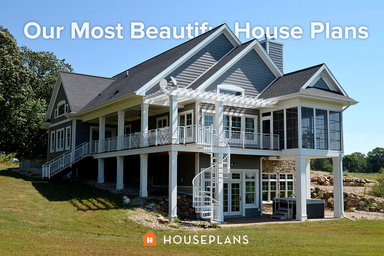The most compelling part of a home can often be a transition zone between rooms, and between indoors and outdoors. Turnbull Griffin Haesloop Architects are especially adept at making such spaces celebrate the setting. Their recent Sonoma house reinvents the classic American dogtrot idea for today (two rooms linked by a breezeway). Here the breezeway is also a dramatic modern outdoor foyer and living room.
Plan 888-17 by architect Nicholas Lee incorporates a breezeway between the main house and the adjacent casita - shown on the left in this photo. Architect Francois Levy's smaller
Plan 450-3 uses the breezeway idea for a contemporary vacation cabin -- it becomes a warm weather living room between the bedroom on one side and the kitchen-dining space on the other.
The open-air corridor or gallery reaches back not only to the dogtrot, but also to other archetypes. New Mexico regional modern architect John Gaw Meem was particularly deft at the use of transitional spaces to tie structure to
site. In his McCormick residence of 1931, north of Santa Fe, the entry is along a covered walkway that opens to a terraced courtyard, as shown above. The portico shades the entrance, creating an outdoor room within the larger outdoor room that is the courtyard (photo by Robert Reck from Facing Southwest: The Life and Houses of John Gaw Meem, by Chris Wilson, W. W. Norton, 2001).
Another example, this time on a slight downhill slope, is the entrance at the Wallace house of 1933 near Santa Cruz, California by Henry Howard. The long corridor, paving pattern, and distant open doorway beckon
eyes and footsteps into and through the house. If there had been no overhang the entrance walk would be abrupt, exposed to the weather, and unwelcoming (photo courtesy Henry Bowles).
Classic American examples of the porch as passage are found in the Charleston, South Carolina single-houses of the 19th century, also called side-yard houses. The front door opens to the porch, which in turn leads to the front hall (in some examples, the porch is the front hall). Here's a design, Plan 900-6
by C3 Studio LLC, echoing that idea. Side-yard houses are houses are usually only one room wide and the porch is oriented to catch the breeze, while in traditional examples the front door preserves the dignity of the street front and the privacy of the porch at the same time.
Add a glass wall and things start to evolve. Mid-century modern architect William Wurster expanded the glazed corridor into what he often called "the room with no name," essentially a sunporch or lanai that could have multiple uses as a kind of family room or indoor-outdoor dining room.
In his Case Study design of the mid-1940s, Plan 529-1, it's simply labeled as a porch but becomes a breezeway/garden room, but is really an indoor dogtrot.
A breezeway can be so much more than a corridor!
Plan 888-17 by architect Nicholas Lee incorporates a breezeway between the main house and the adjacent casita - shown on the left in this photo. Architect Francois Levy's smaller
Plan 450-3 uses the breezeway idea for a contemporary vacation cabin -- it becomes a warm weather living room between the bedroom on one side and the kitchen-dining space on the other.
The open-air corridor or gallery reaches back not only to the dogtrot, but also to other archetypes. New Mexico regional modern architect John Gaw Meem was particularly deft at the use of transitional spaces to tie structure to
site. In his McCormick residence of 1931, north of Santa Fe, the entry is along a covered walkway that opens to a terraced courtyard, as shown above. The portico shades the entrance, creating an outdoor room within the larger outdoor room that is the courtyard (photo by Robert Reck from Facing Southwest: The Life and Houses of John Gaw Meem, by Chris Wilson, W. W. Norton, 2001).
Another example, this time on a slight downhill slope, is the entrance at the Wallace house of 1933 near Santa Cruz, California by Henry Howard. The long corridor, paving pattern, and distant open doorway beckon
eyes and footsteps into and through the house. If there had been no overhang the entrance walk would be abrupt, exposed to the weather, and unwelcoming (photo courtesy Henry Bowles).
Classic American examples of the porch as passage are found in the Charleston, South Carolina single-houses of the 19th century, also called side-yard houses. The front door opens to the porch, which in turn leads to the front hall (in some examples, the porch is the front hall). Here's a design, Plan 900-6
by C3 Studio LLC, echoing that idea. Side-yard houses are houses are usually only one room wide and the porch is oriented to catch the breeze, while in traditional examples the front door preserves the dignity of the street front and the privacy of the porch at the same time.
Add a glass wall and things start to evolve. Mid-century modern architect William Wurster expanded the glazed corridor into what he often called "the room with no name," essentially a sunporch or lanai that could have multiple uses as a kind of family room or indoor-outdoor dining room.
In his Case Study design of the mid-1940s, Plan 529-1, it's simply labeled as a porch but becomes a breezeway/garden room, but is really an indoor dogtrot.
A breezeway can be so much more than a corridor!






